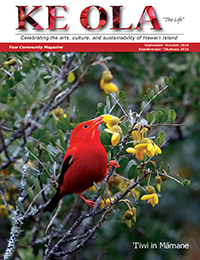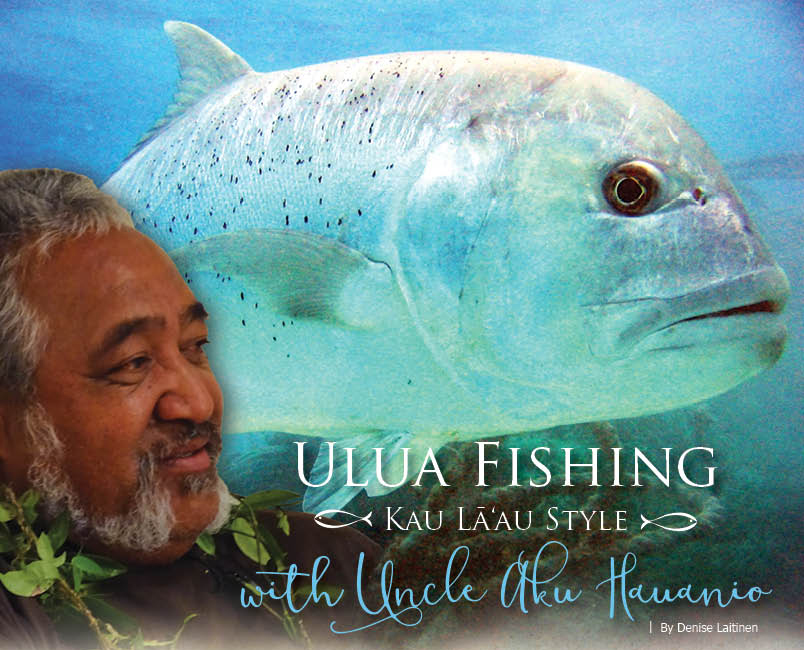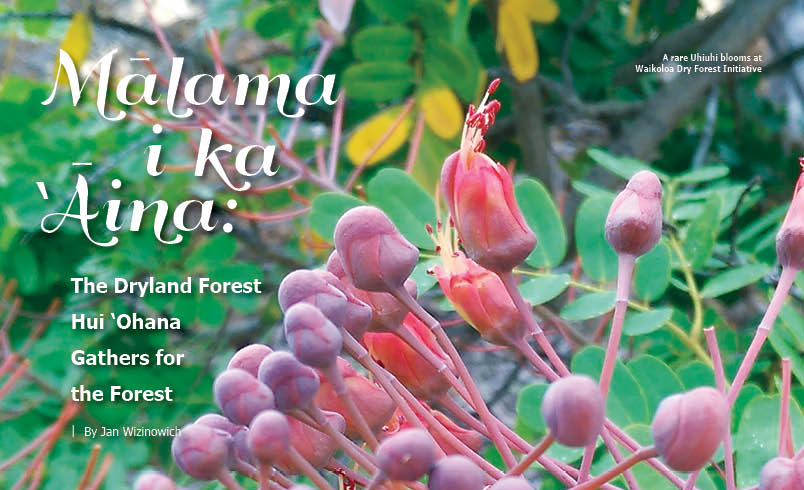
Hawai‘i Island Festival of Birds
By Alan D. McNarie
It’s one of the biggest, yet least-noticed spectator sports on earth. More people participate in birdwatching than go to NFL football games, according to at least one study. There are websites, magazines, and festivals devoted to it, and it’s particularly suited to Hawai‘i—yet Hawai‘i has done relatively little to draw attention to that fact.
That’s about to change. On September 24–25, Hawai‘i Island will play host to the First Annual Hawai‘i Island Festival of Birds—Ha‘akula Manu, at the Sheraton Kona Resort and Spa and elsewhere around the island. The festival will include, among other things, panel discussions with wildlife biologists and birding experts, a class on painting birds with local artist Gretchen Grove, a bird photography class with wildlife photographer Jack Jeffrey (whose work graces this cover, see story on page 83), a silent auction of bird-related items, from art to binoculars—and of course, birdwatching tours, both on land and sea.
General admission to the festival is $10, and there are special fees for some events, including tours and workshops.
The festival will also mark the opening of the Hawai‘i Island Coast-to-Coast Birding Trails, the state’s first serious attempt to foster birdwatching touristry.
“The state of Hawai‘i is one of the few states that does not have a birding trail identified,” notes Jack Jeffrey, who’ll also be leading a special tour emphasizing bird photography.
“The birding trail is not a physical trail, like a hiking trail,” explains festival manager Lisa Brochu.
“It is a route that has been identified with a number of birding hot spots around the island. We really need to help people understand how important it is to preserve the natural areas that support the native species.”
Birdwatching, she adds, is also “a heck of a lot of fun”—a family activity that can happen in a natural area or “your own backyard.”

The trail will begin at Kaloko-Honokōhau National Historic Park, whose ancient Hawaiian fishponds are among the best places in Hawai‘i to see endangered native wetland birds such as the koloa (Hawaiian ducks) and ae‘o (black-necked stilts). It will then ascend the old Saddle Road, passing through the māmane forests, where a little endangered grey, yellow and white honeycreeper, the palila, still flits from branch to branch and the the pueo (Hawaiian owl) hunts by day in the mists. The route then joins Daniel K. Inouye Highway to cross the Saddle and descends through koa and ‘ōhi‘a forests where other honeycreepers, such as the scarlet-and-black ‘apapane, orange ‘ākepa and a plethora of LGBs (little green birds) such as the ‘amakihi and the Hawai‘i creeper feed among scarlet lehua blossoms. It culminates Hilo-side at Loko Waka fishpond in Keaukaha, a good spot to see migratory birds.
In birding parlance, anybody can be a “birdwatcher,” yet true “birders” take it to another level: keeping detailed records of their sightings, often posting them at ebird.org and providing data for professional researchers. Many keep “life lists”: records of all the species that they’ve observed in their lifetimes. Jack, a retired wildlife biologist who spent most of his career restoring native ecosystems in Mauna Loa’s remote Hakalau National Wildlife Refuge, still conducts birders on tours there. Some of his guests, have life lists in the thousands—one visitor claimed 7,000 different species. There are only 10,000 living species of birds world-wide.
“When you start, every bird you see is a new bird,” he observes, “but when you start getting into the thousands, you have to go to special places to find a new bird. People spend a lot of money going to those special places. Hawai‘i is one of them.”
What makes Hawai‘i special for birders is its large numbers of endemic and endangered species.
“Endemic” birds evolved here and are found nowhere else.
“Endangered” birds are so rare that they could soon become extinct.
Hawai‘i, because of its long isolation, has a large number of endemics—and because it’s no longer isolated, many of those birds are now endangered—rare prizes to add to a life list.
Hawai‘i is particularly special because of a single family of birds.
“Over 350 species of honeycreepers evolved out of one bird that came from Asia,” says Jack.
“There are only 18 species left. Seven exist on the Hawai‘i Island.”
Those survivors often aren’t doing well. Only about 2,000 palila (honeycreeper) remain, for instance. The ‘ō‘ū, a little green honeycreeper with a parrot-like bill and (on males) a yellow head, is so rare that it may already be extinct.
Some honeycreepers are not just rare, they’re pretty weird. Take, for instance, one of Rob Pacheco’s favorite birds, the endangered ‘akiapōlā‘au.
Rob owns Hawaii Forest and Trail, which has been conducting bird tours on the island for 23 years. An ‘akiapōlā‘au sighting is still a highlight on any of those tours. To feed on grubs in trees, it’s evolved a very odd bill.
“It has a long curved top bill, and a lower bill that’s short and straight like a woodpecker’s,” explains Rob. “It uses the lower bill to drill into the wood, then uses that top bill to pry that wood away to reach and expose the larva, then it dislocates its lower jaw and brings those two bill tips together like pinchers to grab them.”
One endemic Hawai‘i Island bird won’t be seen on the new trail: the ‘alalā, the Hawaiian crow. The huge black birds—adults are about a foot and a half long—are extinct in the wild. At one point, their numbers were down to about a dozen birds in a captive breeding facility: the San Diego Zoo-run Keauhou Bird Sanctuary. The sanctuary now has over a hundred ‘alalā. It had planned to release some back into their native habitat this September; however, the release date has now been moved to November.
That doesn’t completely eliminate the possibility of seeing one. The Center holds an open house every January, and allows a limited number of tours at other times, with advance reservations. Those who wish to explore the possibility of visiting should contact the Center.
‘Alalā are omnivorous, extremely intelligent, and long lived; they’ve been known to reach 29 years of age in captivity. All of these traits would normally make for a very hardy species. So why is it hovering on the edge of extinction?
The answer: Entire ecosystems, including birds, are collapsing under the onslaught of a horde of introduced species, unnaturally selected and brought here by humans.
Had Darwin visited Hawai‘i instead of the Galapagos, he might have written a somewhat different theory of evolution. Trapped on the most isolated archipelago on earth, a tiny number of root species—including no large native grazing animals, and no endemic predators larger than an ‘io (Hawaiian hawk)—have evolved into a system that’s cooperative as much as it is competitive.
The ‘alalā in the wild, for instance, ate 30 species of native fruits, and the trees relied on them and other birds to spread their seed. Other birds, such as ‘apapane and ‘i‘iwi, evolved long curved beaks to feed on nectar and pollinate flowers in place of bees. Survival of the fittest, in Hawai‘i, became survival of those who fit in.
What’s happening now, however, is Darwinism on steroids: hypercompetitive species from all over the globe are rampaging through delicate native ecosystems like bullies at a tea party.
Cattle and Mouflon sheep have wrecked forests that evolved without any defenses against grazers or browsers.
Roof rats leap from tree to tree like bare-tailed squirrels, attacking eggs and nestlings in a forest canopy that, for millions of years, had no predators at all except for hawks, owls and ‘alalā.
Chameleons from Africa climb to the forests’ uppermost twigs and devour anything up to a third of their body size, including nestlings and even occasional adult birds: a YouTube video, a few years ago, showed a Jackson’s chameleon in Honolulu gulping down a sparrow.
House cats kill rats, which is good. Not good is they also depredate birds—especially seabirds, which for millions of years had been able to nest safely on the ground in Hawai‘i. The cats are joined in that slaughter by mongoose, also introduced to eat rats—except rats are active at night, when mongoose are asleep (and unlike roof rats, mongoose don’t climb).
Kahili ginger, gorse, and strawberry guava are choking out whole forests. Worst of all, perhaps, are mosquitoes carrying avian malaria, for which most Hawaiian birds have no immunity.
Fortunately, Alaskan mosquitoes haven’t made it here, yet. Asian tiger mosquitoes, among others, are spreading farther each year. Residents of Volcano, 3,600 feet above sea level, once regularly heard the songs of endemic birds such as the wren-like ‘elepaio. Now the ‘elepaio songs are mostly gone, replaced by the whine of mosquitoes.
Hope remains, however, at least for some birds—and part of that hope may lie in recruiting birdwatchers and others as volunteers to aid in habitat restoration. Hakalau Wildlife Refuge is one shining example.
“Hakalau wouldn’t be what it is today without volunteers,” says Jack. “Planting trees, picking seeds, weeding, working in the greenhouses, providing environmental education. . . . People came up, had a good time and told their friends.”
For years, Jack worked on forest restoration with classes brought over from O‘ahu by an environmental law professor named Denise. Standing on the porch of the Hakalau ranger cabin on one of these trips, Jack told her, “Someday this cabin is going to be surrounded by forest, and all the birds are going to be here, but it’s not going to happen in our lifetime.”
Denise kept bringing her classes every year for nearly two decades. One day, they were standing on the cabin lānai again. All around the cabin, now, koa trees were growing.
“Denise said to me, ‘Jack, what birds do you hear?’” he remembers.
He listened for a few moments, then replied, ‘I‘iwi, ‘akiapōlā‘au, ‘apapane, ‘elepaio, ‘ōma‘o, ‘amakihi.”
“You used to be able to see all the way to the ocean. Now there all these koa trees are there,” Denise replied, “And you’re still alive.”
“That was an ‘aha’ moment for me,” says Jack. “In less than 20 years, it’s happening.” ❖
Hawai‘i Island Festival of Birds— Ha‘akula Manu
September 24-25, 2016
Celebrate Hawai‘i’s unique blend of birds—from native honeycreepers found nowhere else in the world to common backyard birds from five continents.
The first annual Hawai‘i Island Festival of Birds—Ha‘akula Manu, brought to you as a program of Peoples Advocacy for Trails in Hawaii (PATH), will signal the official opening of the Hawai‘i Island Coast to Coast Birding Trail (another first for the state!).
The Trail’s 90-mile cross-island route links a remarkably varied set of locales, featuring a broad representation of island birdlife, nature, geology, history, and scenic vistas. Rising from sea level to 7,000 feet and back again between the two tallest mountains on earth, the trail passes through desert with a few inches of rain annually and through tropical rainforest with nearly 300 inches of rainfall a year.
Imagine the trail’s diversity of landscapes and climates matched by the diversity of birds, including endangered waterbirds and forest birds, migratory waterfowl and shorebirds, including such notable species as Nēnē, Hawai‘i ‘Amakihi, ‘Ōmao, Hawai‘i ‘Elepaio, ‘Apapane, ‘I‘iwi, Hawaiian Hawk, Hawaiian Coot, and the endemic sub-species of the Black-necked Stilt, and Short-eared Owl (Pueo), and numerous established non-native species.
Who Should Come
The Hawai‘i Island Festival of Birds—Ha‘akula Manu is a place where residents and island visitors with all levels of interest in birding and nature study can come together to discover and celebrate the diversity of Hawai‘i’s birdlife and the habitats that support them. If you’re a resident of the island (including students) with a desire to experience the wild and natural resources of your island home, an avid birding and nature tour group in search of Hawai‘i’s wildlife, or a casual nature enthusiast visiting the island, we’d love to see you at the first annual Hawai‘i Island Festival of Birds—Ha‘akula Manu.
Saturday, September 24
All Saturday activities feature the birds of Hawai‘i and are held at Sheraton Kona Resort and Spa at Keauhou Bay.
Sunday, September 25
Sunday activities begin and end at various points in Kailua-Kona and Hilo (to be determined) and at Waiki‘i Ranch.
Contact Hawai‘i Island Festival of Birds
Contact Hakalau Wildlife Refuge
Contact Keauhou Bird Sanctuary: 808.933.2988
Contact photographer Bonnie Nims
Contact photographer Pamela Bell
Contact writer Alan D. McNarie
Volunteer to help with native bird habitat restoration:
Hakalau National Wildlife Refuge
Hawaii Volcanoes National Park
Kohala Watershed Partnership
Mauna Kea Forest Restoration Project



